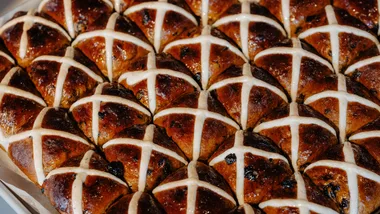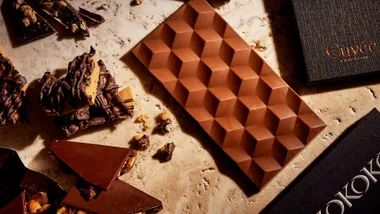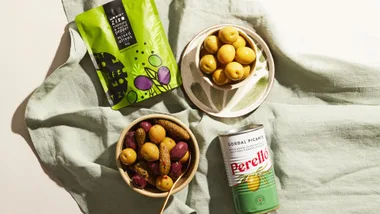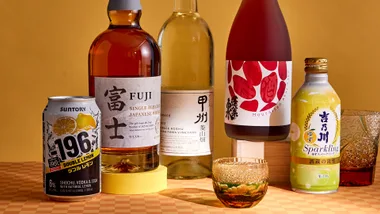On a freezing cold day in the dead of winter, dozens of chefs – almost uniformly dressed in black puffer jackets and chunky boots – are gathered in a semi-circle on the dusty floor of a farm shed in Mypolonga, a tiny town on the banks of the Murray River in South Australia. Aalia’s Paul Farag is there, as is Joel Bickford from Shell House, Mark Best, Cheong Liew and others. Sarah Asciutto, co-owner of Rio Vista Olives who owns the grove and the huge mint-green Italian olive press in the shed next door, is handing out tiny tasting cups of olio nuovo extra-virgin olive oil – the first-pressed, freshest oil of the year. She talks the chefs through the subtleties and nuances of each flavour profile. Fresh tomato leaves, she says of one and it’s hard not to feel transported to a sun-splashed summer garden. Stone fruits. Green beans. Candied bananas. Some are nodding, others are furrowing their brows almost imperceptibly – especially at the banana lolly bit. But almost all of them appear intrigued. No one here is a stranger to olive oil of course but deep diving into the complexities of single olive varietals is – at least for some – a fresh take.
In the last couple of decades, the Australian olive oil industry has started to get beautifully boutique, not unlike the way Australian wine did in the 1980s. And similar to our wine industry, as a country we punch well above our weight – if not in quantity, certainly in quality. If you scan the list of winners from 2022’s New York World Olive Oil Competition – considered to be the most prestigious extra-virgin olive oil contest in the world – Australian oils came a very respectable 10th out of 28 countries. Not bad considering it only produces 0.5 per cent of the world’s oils.
The majority of our output is dominated by one name – Cobram Estate, which is responsible for around 65 to 70 per cent of all Australian output. “They’re one of the world’s largest anywhere, because typically in Europe olive oil farms are family operations that collaborate with cooperatives,” says David Valmorbida, president of the Australian Olive Oil Association. “But then we have this emerging group of mid-sized growers – beautiful brands like [The Hunter Valley’s] Pukara Estate and Mount Zero. And then there are the boutique guys – the grassroots.” They all have their place – it’s widely agreed within the industry that the mass-market but consistently high-quality Cobram Estate has been a godsend in terms of raising the profile of Australian oils overall – but it’s the little guys where the really exciting stuff is happening.
Olives tend to like the same terroir and climate as grapes, so Australia’s main growing regions are around Victoria, South Australia and Western Australia. One of these boutique producers is Goldi, a brand from a family-run farm in Kialla, in Victoria’s Goulburn Valley. Headed up by Janine Fahey and her sister-in-law Dina Sminova, they produce two main single-variety oils: their “punchy” Coratina, an Italian olive, and milder Arbosana, which is native to Spain.
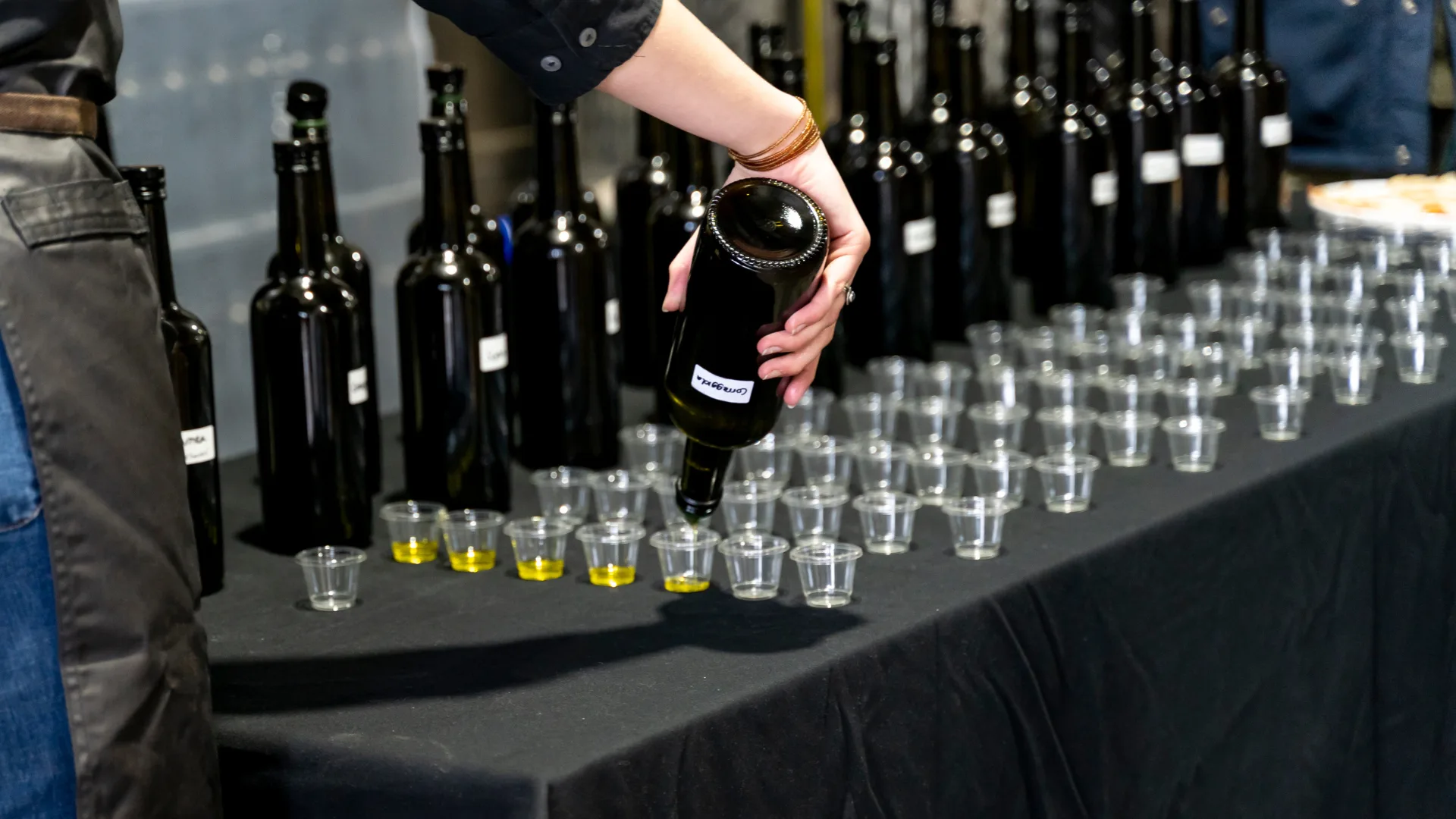
Originally, the family sold their product to chefs but in 2021 they started getting so much demand from family and friends that they began selling directly to consumers. Like Rio Vista, Goldi presses its own oil (and occasionally helps its neighbours do the same) rather than sending it elsewhere for processing, which Fahey says is one of the benchmarks to look out for when selecting a quality local oil. “The sooner you press the better quality of the oil, especially when you can control the temperature,” says Fahey.
She thinks Australians are increasingly recognising the quality of Australian brands. “Previously I think people thought quality only came from Europe,” she says. “And I think once they’d use any old rancid oil. But now people are so much more aware of flavour, and they’re interested in traceability and where their food comes from.”
Of course, chefs have been interested in homegrown oils for a long time. Peter Gunn from Ides and March in Melbourne has been devoted to Australian olive oil for most of his cooking career, specifically Mount Zero from the Grampians region of Victoria. Today, Mount Zero olive oil forms the base of all his restaurants’ flavoured oils, including a waxflower oil that he serves with pickled pumpkin, and a mountain yuzu-infused oil that dresses an almond chocolate cake. “I always want to use a product that’s as fresh as possible,” he says – and with olives harvesting in late autumn and winter, a northern hemisphere oil is always going to be staler when Australian oils are at their peak. “That’s not to disrespect the foundations of olive oil, or where beautiful olives come from originally. It’s just about staying true to our locality.”
Ibrahim Kasif, of Nomad offshoot Beau, concurs. He’s a Rio Vista fan, particularly its garlic- and turmeric-infused flavoured oils. “Coming from a Turkish background, olive oil is a big part of our culture, and at the forefront of every meal,” says Kasif. “Rio Vista’s oil is an example of the kind of oil my family has always loved – my aunties, uncles, grandparents. There’s high quality stuff going on there.” That’s not to say he won’t be using European or Middle Eastern olive oils at all at Beau – there’s a Cypriot sun-dried black olive oil that has no equivalent here that he can’t wait to get his hands on for salads and pulses. But Australian oils, he says, “go blow-for-blow with them.”
As one of the largest consumers of olive oil outside of the Mediterranean – Australians glug through around 50 million litres per year – our appetite for homegrown good oil shows no signs of slowing, especially as uncertainty hits the northern hemisphere market thanks in part to droughts and conflicts in Europe and as people recognise the benefits of buying their oils fresh and local. “People are saying, hey, we want high polyphenol levels, we want the antioxidants, we want the squalene, we want flavour profiles and quality,” says Asciutto. “I think it’s really exciting.”
What are the different varieties of olive oil?
More than 100 olive varieties are grown in Australia, each with a different flavour personality. We asked Australian-owned olive oil brand Rio Vista’s olive oil sommelier Sarah Asciutto to explain the most popular.
A small-fruited Greek variety with lively notes of candy bananas and fresh oregano and thyme. Paul Farag uses it with his signature cuttlefish, ummak huriyya salad and couscous dish at Aalia in Sydney. “The tropical notes lift the cuttlefish,” says Asciutto.
This hardy Spanish varietal is known for its high oil content and full-bodied flavour profile: tomato vine, fig leaves and summer fruits. “I think of it like a summer garden where you’ve brushed up against the tomato leaves,” says Asciutto. The team at Nomad Melbourne use it in their ice-cream sandwich. “It’s quite savoury so putting it on something sweet turns it on its head, while bringing out its other flavour notes like stone fruits and citrus.”
First grown by the Hardy’s wine family in South Australia, this plump green olive of unknown lineage is a uniquely Australian variety. Its oil is popular in desserts thanks to its passionfruit, guava and cardamom notes but it also comes alive when used to finish white-fleshed fish. Tom Tilbury at Adelaide’s Press Food and Wine uses it on his kingfish, peppers, fennel and fragrant herbs. Asciutto explains, “You’ve got the sweetness of the fish, and then the Hardy’s Mammoth adds this bright fruitiness.”
One of the most popular varieties grown in Australia, this Spanish cultivar generally has tomato notes in its profile, says Asciutto, “It pairs well with tomato-based foods, beef stews and roast pork.”
If you’re not buying individual varietals and want more all-purpose oils, Asciutto says, a good guide is to think of olive oil intensity like wine – milder flavours work with lighter, fresher food and vice versa. “Mild oils [which are generally on the fruity side] are great for baking, for making mayonnaise or for a delicate fish,” she says. “Classic oils, which have a bit more pepperiness, are great as a base to a pasta sauce or on a paella or for roasting vegetables.” Robust oils, which are strong and peppery, are for finishing – splashed over a steak or for dipping in bread. “They’re even good for something like prawns,” says Asciutto, “which have that strong flavour, to lift them up.”
Expert tip
 Kristina Soljo
Kristina Soljo
